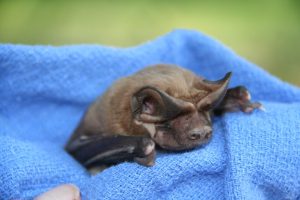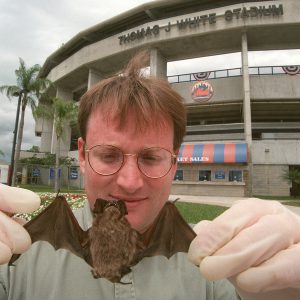- April 15 marks the start of bat maternity season, and through August 15 wildlife protection laws are in place.

The Florida bonneted bat is the largest bat in the state and can reach a length of 6.5 inches with a wingspan of 20 inches. Its diet primarily consists of insects, which makes them a great natural pest control. Photo Courtesy FWC
- Though they have benefits to the environment, bats can be misunderstood.
- University of Florida experts at the Institute of Food and Agricultural Sciences (UF/IFAS) want to clear misunderstandings about bats, ease apprehensions about their habits, and provide insights on how to help bats thrive during this season by simply staying clear of them.
FLORIDA- It’s maternity season for Florida bats, which means they might be roosting in or near your home at this time.
UF/IFAS scientists say these flying mammals are often misunderstood and feared.
Because bats in Florida are very adaptable to urban, suburban and rural settings, property owners may not realize these critters have selected their homes or buildings as their new nesting place.
“In Florida, we have 13 native species that reside here year-round. They are mostly active at night, so most people don’t even realize they’re there,” said Ken Gioeli, a UF/IFAS Extension St. Lucie County wildlife agent who specializes in environmental and natural resources. “Bats are not blind, another misconception, but they rely on their sense of echolocation to navigate and hunt insects – a form of natural pest control benefitting people.”
Clearing up these misconceptions is important to note because occasionally the needs of bats come into conflict with people.
To help residents better understand their beneficial bats, Gioeli provides the following insights from research conducted by multiple scientists over the years at UF/IFAS.

Q: How common are bats in Florida?
A: Bats in South Florida are very adaptable to living around people. They live in urban, suburban and rural settings. Sometimes they live in dwellings, buildings and bridges, at times by the hundreds of thousands.
Q: Do humans encounter these bats? If so, what are some of the important points they should keep in mind with respect to feeding or interacting with them?
A: Most Florida bats are colonial, meaning they live in big groups. If people or pets encounter a bat on or near the ground, that is an indication that something is wrong. Sometimes baby bats fall out of roosts and can’t return. Other times, bats can contract deadly diseases like rabies which causes them to fall to the ground. These are called zoonotic viruses. There is a danger of contracting the virus from improperly handling bats that are infected.
Q: Should residents and property owners report them to an entity if they come across them?
A: If you encounter a bat on the ground, don’t handle it or transport it in a vehicle, and make sure to remove your pets from the area. Call your local animal control or reach out to a wildlife rehabilitator for help. For bats in buildings, Floridians can use a search engine and look for “Florida bat exclusion experts.” Be very warry of any wildlife “expert” willing to perform a bat exclusion during bat maternity season as wildlife professionals should know about the laws protecting bats during this time.
Q: What is bat maternity season and why is it important?

A: Bat maternity season is April 15 – August 15. During this time, sometimes bats reside in spaces like attics, eaves, chimneys and even buildings and bridges where they roost and raise their pups. By law, bats cannot be excluded from structures. Exclusion is the process of safely removing bats from these dwellings by installing one-way doors. These one-way doors are used allowing bats to leave the dwellings but not return. During maternity season, exclusion is prohibited. During this time, mother bats leave the roost to forage for insects and leave the pups back in the roost. When mother bats attempt to return to the roost after hunting insects at night, the exclusion devices prevent them from gaining access to the space where their baby bats are found. This causes a scenario where the baby bats will die from lack of maternal nursing. This wildlife protection keeps this from happening.
Q: Should people be scared or concerned about bats in urban areas?
A: There are a lot of myths and misconceptions about bats. Dracula movies don’t help. I’ve studied vampire bats in the humid tropics of Central America. We just don’t have vampire bats in Florida. The bats we do have provide many environmental benefits, such as controlling insect pests.
-30-
By: Lourdes Mederos; rodriguezl@ufl.edu
The mission of the University of Florida Institute of Food and Agricultural Sciences (UF/IFAS) is to develop knowledge relevant to agricultural, human, and natural resources and to make that knowledge available to sustain and enhance the quality of human life. With more than a dozen research facilities, 67 county Extension offices, and award-winning students and faculty in the UF College of Agricultural and Life Sciences, UF/IFAS brings science-based solutions to the state’s agricultural and natural resources industries, and all Florida residents.
ifas.ufl.edu | @UF_IFAS
 2
2
